On Feb. 8, I wrote my first installment in a series of trade deadline articles that focuses on teams and players the Nashville Predators should target at the deadline. In that initial article I brought up the Ottawa Senators and suggested that general manager David Poile should target Mark Stone and/or Matt Duchene. Today, I discuss the New York Rangers.
Related: Predators’ Trade Deadline Targets – Ottawa Senators
The 2018-19 Rangers
Trading away Rick Nash, Ryan McDonagh and J.T. Miller at the 2018 Trade Deadline confirmed the message sent to fans by leadership: that a rebuild was on the horizon. Therefore, their 10-8-2 record after 20 games this season was a surprise considering they finished eighth in the Metropolitan Division last season. However, since the 20-game mark, they have a 14-15-6 record and find themselves in seventh place in the division and in the position of seller again.
Related: Predators’ Trade Deadline Strategies
It’s been quite the drop-off since the Rangers reached the 2014 Stanley Cup Final and had three consecutive playoff appearances before missing them last season for the first time since 2009-10. That absence resulted in Alain Vigneault losing his job and being replaced by former Boston University coach David Quinn in his first NHL experience. Now, the roster is almost unrecognizable from the team that reached the Cup Final as Jesper Fast, Chris Kreider, Henrik Lundqvist, Marc Staal and Mats Zuccarello are the only remaining players.
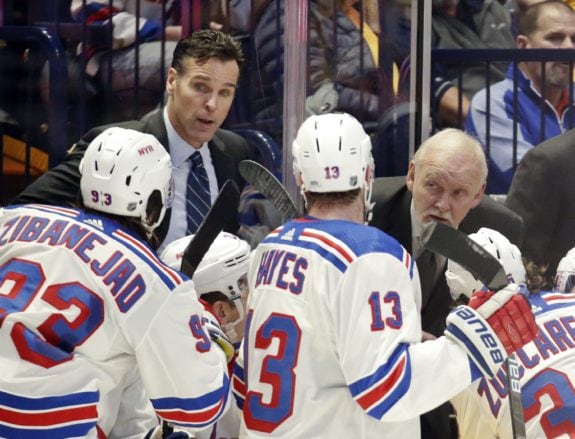
But that’s not a bad thing because, all of a sudden, the Rangers have one of the league’s better prospect pools thanks to management getting in front of the rebuild and dealing players while they still had value. This was smart because they are unlikely to bottom-out the way the Buffalo Sabres, Edmonton Oilers and Toronto Maple Leafs did due to Lundqvist’s play in net.
This season’s deadline is likely to be similar to last season’s. Their goal should be to part with free agents, and even deal any players under contract who aren’t part of the future core. That means pending unrestricted free agents (UFAs) Kevin Hayes, Adam McQuaid and Zuccarello are all-but certain to be available. But will pending restricted free agent Pavel Buchnevich, or even Jimmy Vesey, Kevin Shattenkirk, Kreider and Staal, all with term left, be available?
We likely won’t know until 3:00 pm EST on Feb. 25 what the full of extent of the Rangers’ sell-off will be, but this team has gone all-in on a rebuild and that will likely continue at the 2019 Trade Deadline. For the Predators, a team I feel needs depth on the blue line and possibly a second-line winger and center, they should inquire about the Rangers’ available players. Specifically, I think this means looking into Hayes, Zuccarello and McQuaid.
Kevin Hayes
Hayes is a 26-year-old left-shot center who also plays the wing. He has a big frame at 6-foot-5 and 216 pounds and is a UFA with a $5.175 million cap hit.

Centers Rangers’ Best Line
In 2018-19, Hayes has played in 46 games with 13 goals and 38 points and is shooting below his career average at 11.7 percent while averaging a career-high 19:36 per-game. He is also winning 48.4 percent of faceoffs, has a minus-six turnover margin and is averaging .28 goals-per-game (G/G) and a career-high .83 points-per-game (P/G).
At five-on-five, he is averaging a career-high 13:50 per-game with .57 goals-per-60 (G/60), 2.17 points-per-60 (P/60), attempting 7.16 shots-per-60 (S/60) and is shooting a career-low 7.89 percent. He is, however, generating a career-high 8.67 individual scoring chances per-60 (iSCF/60).
Related: Rangers & Hayes – The Final Countdown?
Throughout the season, he has mostly played on a line with Filip Chytil and Kreider, the team’s most dominant possession line. However, more recently he has centered a line with Buchnevich and either Fast or Vesey. Hayes has been the most impactful player on his line regardless of linemates.
In 83 minutes with Chytil and Kreider, the line has the following metrics: 57.1 shots for percentage (SF%), 62.5 goals for percentage (GF%), 62.7 scoring chances for percentage (SCF%) and 69.7 high-danger chances for percentage (HDCF%). In 23 minutes when Chytil and Kreider have played together without Hayes, their metrics have dropped considerably.
| SF% | GF% | SCF% | HDCF% | |
|
Hayes with Chytil and Kreider |
57.1 | 62.5 | 62.7 | 69.7 |
| Chytil and Kreider without Hayes | 43.5 | 52.4 | 46.7 |
51.8 |
In 34 minutes with Buchnevich and Vesey, Hayes’ second-most common linemates, the trio again has strong metrics apart from scoring chances for and high-danger chances for percentages. In 70 minutes without him, Buchnevich and Vesey’s metrics drop in all areas but high-danger chances for.
| SF% | GF% | SCF% | HDCF% | |
| Hayes with Buchnevich and Vesey | 53.7 | 66.7 | 48.8 | 40.9 |
| Buchnevich and Vesey without Hayes | 37.8 | 50.0 | 33.3 | 44.8 |
On the power play, he has three goals and seven assists while averaging a career-high 2:29 per-game. Those scoring totals equate to 1.61 G/60 and 5.36 P/60 while averaging 10.2 S/60 and shooting 15.8 percent. He has been on the Rangers’ top unit with Mika Zibanejad, Kreider and Zuccarello up front. That trio has been on the ice for seven of the Rangers’ 32 power play goals, or 21.9 percent. Individually, Hayes has been on the ice for 13, or 40.6 percent, of the team’s power play goals.
Hayes also kills penalties and averages 2:00 of shorthanded time per-game. He has one goal and one assist while shorthanded on the season. He has been on the ice for nine, or 22 percent, of the 41 power play goals allowed by the Rangers.
What Would He Bring to the Predators?
Hayes is a great two-way forward who is versatile enough to play center or on the wing. He is a left-shot, something the Predators need. He possesses a big frame but doesn’t rely on physicality to succeed. Although he’s a two-way player, he was skilled enough offensively to play on a line with Johnny Gaudreau when they were at Boston College. With his big frame, Hayes wasn’t always the smoothest skater, an aspect he has worked on over the years.
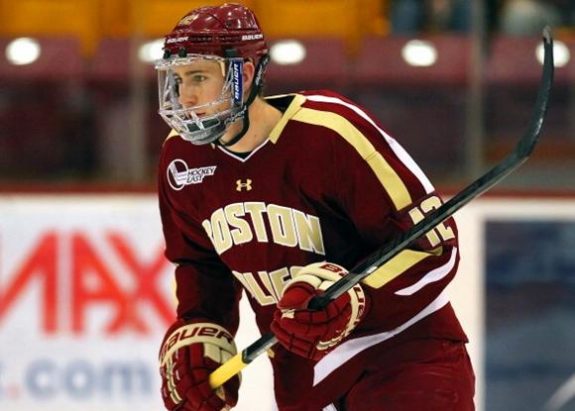
He would seamlessly slot onto the Predators’ second line, either bumping Kyle Turris, a right-shot, to the wing, playing on the wing himself, or perhaps a combination of both to allow each player the opportunity to take faceoffs on his strong side. But for his offensive skills, it is Hayes’ ability to positively impact his teammates that stands out.
Hockey Viz’s heat maps convey that the Rangers have played much better with him on the ice than off. For example, at five-on-five, the Rangers are a plus-four percent threat to score relative to league average with Hayes deployed but are a minus-nine percent threat with him off the ice.
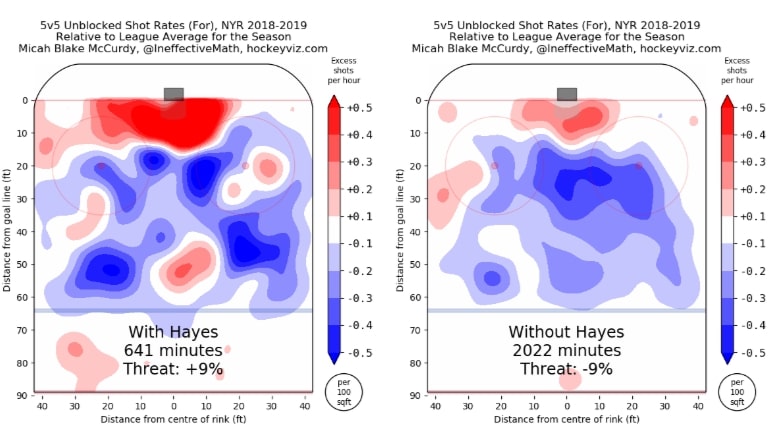
It’s a similar story in shots allowed by the Rangers as their opposition’s threat is 11 percent below average with Hayes on the ice and 12 percent above average when he’s not deployed. The same holds true on the power play and penalty kill. Based off this, he would have a significant positive impact on the Predators.
What Would He Cost?
Unlike Duchene and Stone, I don’t think there would be much of an appetite by Poile to extend Hayes. Because of that, crafting a package to acquire him is based on the understanding that he’d be a playoff rental. The San Jose Sharks’ acquisition of Evander Kane is a good comparison. The Sharks gave up a conditional first and fourth-round pick and mid-tier prospect Danny O’Regan to land Kane. The first-round pick was conditional on the Sharks re-signing Kane, which they did. But if they hadn’t, the pick would have been a second-rounder.
Using that as an example, I think Poile giving up a similar conditional first-round pick, a mid-round selection and a mid-tier prospect like Yakov Trenin or the rights to David Farrance, currently a sophomore at Boston University, would get the deal done. I’m sure the Rangers would love to get their hands on Dante Fabbro, also at B.U., but there’s no chance Poile parts with Fabbro for a playoff rental.
Mats Zuccarello
Zuccarello is a 31-year-old left-shot left winger who will be a UFA this offseason. He currently has a $4.5 million cap hit.
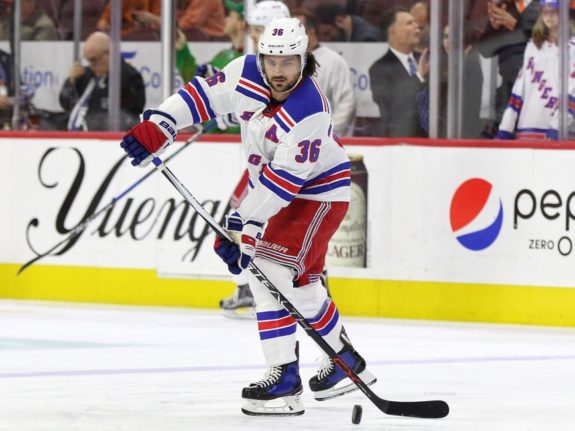
Excellent Two-Way Player
In 41 games this season, Zuccarello has nine goals and 32 points and is shooting 11.1 percent, a half-percent higher than his career average of 10.6, while averaging a career-high 19:44 per-game. He has a plus-six turnover margin and is averaging .22 G/G and a career-high .78 P/G.
At five-on-five, he is averaging 14:10 per-game, .72 G/60, 1.96 P/60, 5.89 S/60, 6.71 iSCF/60 and 3.3 individual high-danger chances for per-60 while shooting 12.3 percent. He is currently playing on the Rangers’ top line with Kreider and Zibanejad, and in 179 minutes together, the line has dominated five-on-five play. In 223 minutes without him on the line, Kreider and Zibanejad still have positive metrics, although there is a slight regression.
| SF% | GF% | SCF% | HDCF% | |
| Zuccarello with Kreider and Zibanejad | 57.2 | 76.0 | 63.9 | 64.9 |
| Kreider and Zibanejad without Zuccarello | 52.6 | 40.0 | 51.3 | 51.0 |
Zuccarello has played a good bit on the power play, averaging 2:57 per-game. He has been productive in those minutes with two goals and 10 assists on the man advantage, which translates to averages of .99 G/60 and a career-high 5.93 P/60. He plays on the Rangers’ top unit with Hayes and has individually been on the ice for 20, or 62.5 percent, of the team’s power play goals.
Additionally, like any good two-way forward, Zuccarello is an effective penalty killer and is used a lot with 1:35 per-game, a career high. He has been on the ice for 13, or 31.7 percent, of the power play goals allowed by the Rangers.
What Would He Bring to the Predators?
First and foremost, it starts with Zuccarello’s speed, a tool that would fit perfectly on the Predators, a team that thrives on speed, whether it’s through the neutral zone, chasing down dumped-in pucks or on the backcheck. But then there’s also his high hockey IQ that puts him in the right spot at the right time and his plus vision and hands that help him score and make difficult passes.
His ability as a good two-way forward would also fit on the Predators roster as a large portion of their best forwards play in all situations. Then there’s the fact that he’s a great locker room guy and a left-shot, both aspects that can’t hurt the current rendition of the Predators.
Plus, like Hayes, Zuccarello is a positive-impact player. At five-on-five, the Rangers are a plus-six percent threat to score with him on the ice and a minus-eight percent threat without him. On the power play, the team attempts a lot more shots from the left side with him than without him, which is a location the Predators have struggled to generate shots from. Surprisingly, he doesn’t make a difference to the Rangers’ penalty kill.
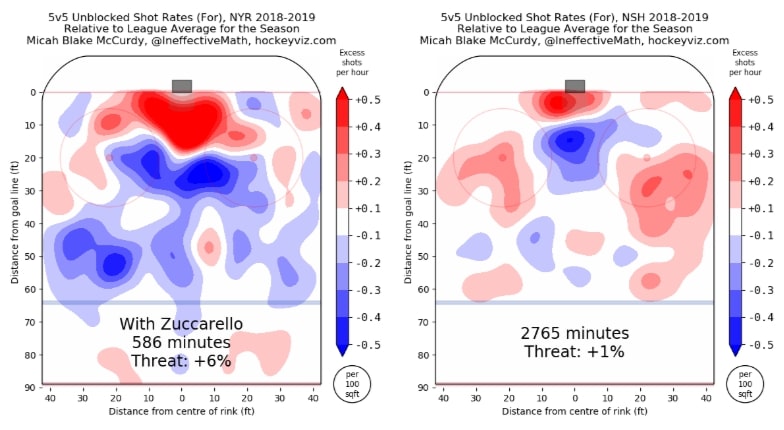
What Would He Cost?
Because Zuccarello would only be considered a playoff rental given his age and the possibility that he re-signs with the Rangers in the offseason, I doubt he fetches a large return. I’m thinking a package that includes a second or third-round pick and a mid-tier prospect like Trenin or Farrance, similar to the packages the New Jersey Devils parted with for Michael Grabner and Patrick Maroon last season would work. That, or an upper-tier prospect like Alexandre Carrier or Frédéric Allard and a lower-round draft pick may get the deal done.
Adam McQuaid
McQuaid is a 32-year-old right-shot defenseman who is a UFA this offseason. His current contract has a $2.75 million cap hit.
Veteran, Shutdown Defender
In 31 games this season, McQuaid has two goals and five points while averaging 17:40 per-game. He has a minus-three turnover margin and is averaging a career-high .06 G/G and .16 P/G. He is a defensive defenseman who has never been known as an offensive producer.
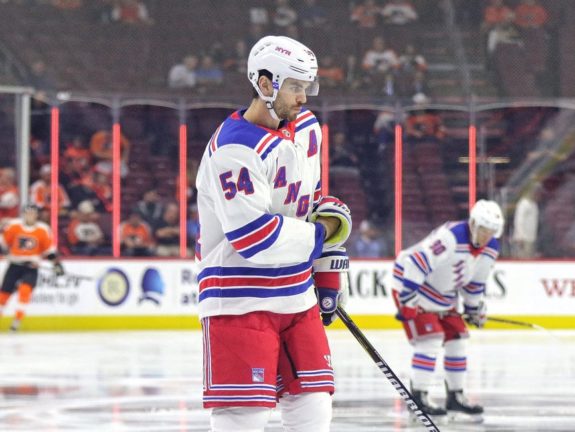
At five-on-five, he is averaging 14:58 per-game, .26 G/60, .52 P/60, a career-low 1.94 S/60 and is shooting a career-high 13.3 percent. He has mostly been paired with Brady Skjei and they are the Rangers’ second-most used defense pair, at 391 five-on-five minutes. They have the third-lowest offensive zone start percentage at 22.7 and the highest neutral zone start percentage at 46.7.
When McQuaid and Skjei have played together, the pair has slightly below-average metrics with only their goals for percentage at or above 50 percent. However, in the 528 minutes that Skjei has played with a different partner, his metrics have tanked. That’s not a surprise as he is on three of the Rangers’ four worst pairs in terms of metrics.
| SF% | GF% | SCF% | HDCF% | |
| McQuaid and Skjei |
45.4 |
50.0 | 45.8 |
48.5 |
| Skjei without McQuaid | 45.1 | 42.6 | 42.4 |
44.0 |
McQuaid doesn’t play on the power play, but has been a stalwart on the penalty kill, averaging 2:15 per-game this season. He has been on the ice for eight, or 19.5 percent, of the power play goals allowed by the Rangers and they have allowed a power-play goal in eight of the 31 games McQuaid has played this season.
What Would He Bring to the Predators?
McQuaid is a steady, veteran defensive defenseman who could either play on the third pair with Dan Hamhuis or be a seventh defensemen when Matt Irwin plays. As a right-shot blueliner, McQuaid would provide the Predators shot balance on every pair, not a necessity, but an advantage. He’s also a leader with lots of playoff experience, having won a Stanley Cup with the Boston Bruins in 2011. That could come in handy down the stretch and in the postseason, especially if Fabbro signs his entry-level contract and joins the team.
Although McQuaid’s metrics don’t look great, partially the result of receiving so few offensive zone starts, he is a positive impact on the ice. When he is off the ice, the Rangers have allowed significantly more shots from the right side than when he is deployed. That holds true both at five-on-five and on the penalty kill.
That’s the kind of defenseman the Predators could use, especially in shutdown situations. At five-on-five, his 28.8 shots-against per-60 would be fourth-lowest among Predators defensemen and his 2.46 goals-against per-60 would be sixth-lowest. Although his goals-against per-60 stat isn’t ideal, Rangers’ goaltending is somewhat responsible for that as they have a .915 save percentage (SV%) at five-on-five. Meanwhile, on a team like the Predators, with a .926 SV%, McQuaid’s goals-against per-60 rate would rapidly improve.
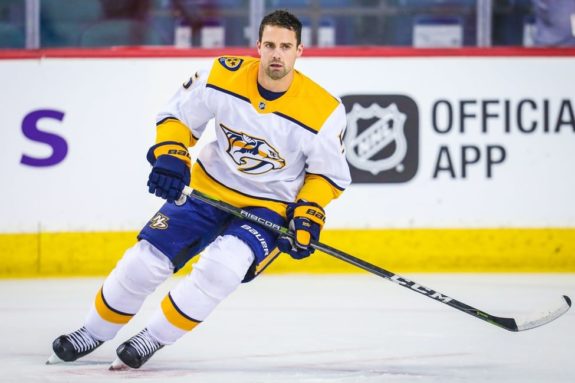
What Would He Cost?
Sixth and seventh defensemen, especially rentals, don’t cost much on the trade market. Last season, Joe Morrow, Mike Reilly, Ian Cole, Brandon Davidson, Nick Holden and Michal Kempny were all dealt at the trade deadline. None of them cost more than a third-round pick and a lower-tier prospect. Poile could acquire McQuaid for pocket change and bolster his blue line in a big way.
Will Any of These Deals Happen?
For starters, there’s a reason I covered the Senators first. I believe they should be the Predators’ top trade target because Stone and Duchene offer a lot of value, more than Hayes, Zuccarello or McQuaid do. However, if Poile misses out on either Senator, Hayes and Zuccarello are cheap second options, considering both would likely be rentals. I feel that both could be a solid fit for Nashville and both would fit Peter Laviolette’s system. And, given the cost of one or both, there’s a deal to be made here.
That being said, I actually think the best option on the Rangers is McQuaid. The Predators need more prominent help at forward than they do on the blue line. That means Poile should make a ‘swing for the fences’ type of trade to acquire a forward, and then add depth at defense. McQuaid is the perfect player for that – he’s a right-shot, steady and quiet blueliner with playoff experience.
Do you think there is a trade to be made between Nashville and the Rangers at this season’s trade deadline? Let me know in the comments below.